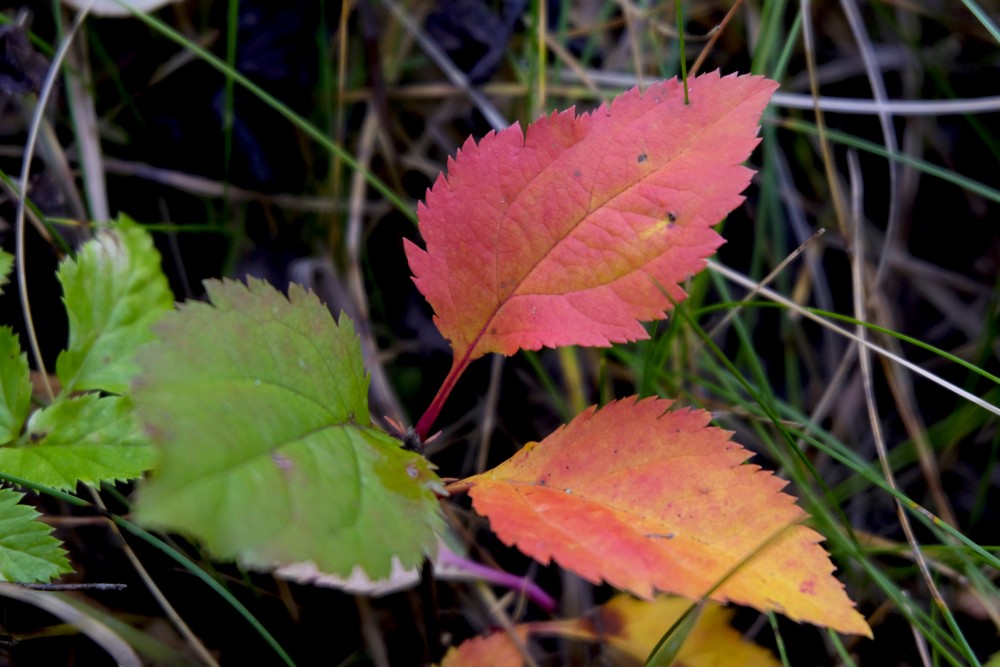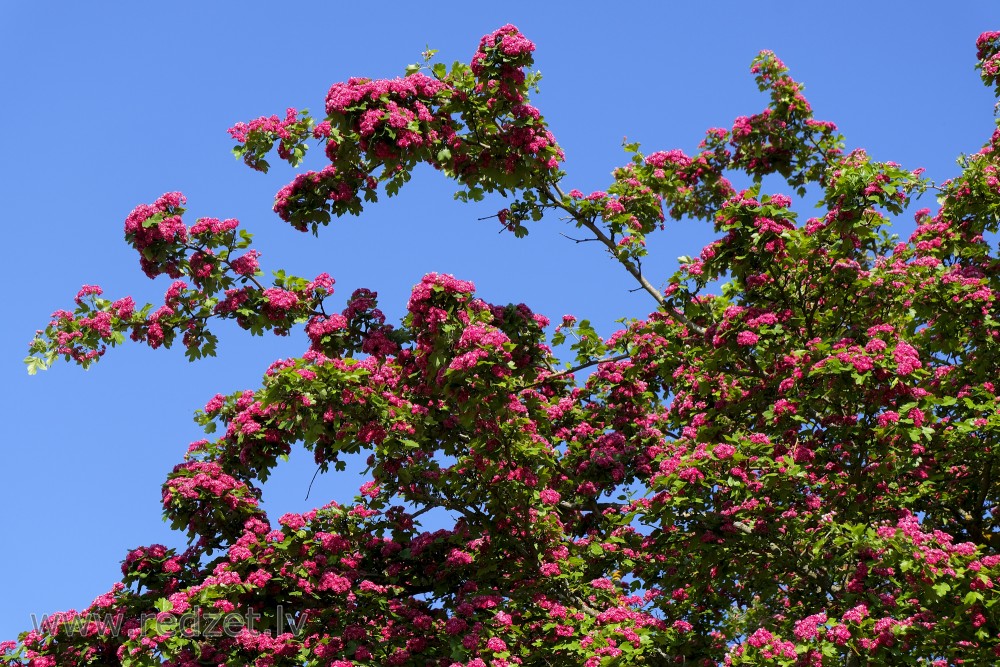Crataegus (Hawthorn)
Crataegus (/krəˈtiːɡəs/), commonly called hawthorn, quickthorn, thornapple, May-tree, whitethorn, or hawberry, is a genus of several hundred species of shrubs and trees in the family Rosaceae, native to temperate regions of the Northern Hemisphere in Europe, Asia and North America. The name "hawthorn" was originally applied to the species native to northern Europe, especially the common hawthorn C. monogyna, and the unmodified name is often so used in Britain and Ireland. The name is now also applied to the entire genus and to the related Asian genus Rhaphiolepis.
| Crataegus | |
| Kingdom: | Plantae |
| Clade: | Angiosperms |
| Clade: | Eudicots |
| Clade: | Rosids |
| Order: | Rosales |
| Family: | Rosaceae |
| Subfamily: | Amygdaloideae |
| Tribe: | Maleae |
| Subtribe: | Malinae |
| Genus: | Crataegus |
Description
Crataegus species are shrubs or small trees, mostly growing to 5–15 m (16–49 ft) tall,[9] with small pome fruit and (usually) thorny branches. The most common type of bark is smooth grey in young individuals, developing shallow longitudinal fissures with narrow ridges in older trees. The thorns are small sharp-tipped branches that arise either from other branches or from the trunk, and are typically 1–3 cm long (recorded as up to 11.5 cm (4.5 in) in one case). The leaves grow spirally arranged on long shoots, and in clusters on spur shoots on the branches or twigs. The leaves of most species have lobed or serrated margins and are somewhat variable in shape. The fruit, sometimes known as a "haw", is berry-like but structurally a pome containing from one to five pyrenes that resemble the "stones" of plums, peaches, etc., which are drupaceous fruit in the same subfamily.
Ecology
Hawthorns provide food and shelter for many species of birds and mammals, and the flowers are important for many nectar-feeding insects. Hawthorns are also used as food plants by the larvae of a large number of Lepidoptera species, such as the small eggar moth, E. lanestris. Haws are important for wildlife in winter, particularly thrushes and waxwings; these birds eat the haws and disperse the seeds in their droppings.
Uses
Culinary use
The "haws" or fruits of the common hawthorn, C. monogyna, are edible, but the flavor has been compared to over-ripe apples. In the United Kingdom, they are sometimes used to make a jelly or homemade wine. The leaves are edible, and if picked in spring when still young, are tender enough to be used in salads. The young leaves and flower buds, which are also edible, are known as "bread and cheese" in rural England. In the southern United States, fruits of three native species are collectively known as mayhaws and are made into jellies which are considered a delicacy. The Kutenai people of northwestern North America used red and black hawthorn fruit for food.
On Manitoulin Island, Ontario, some red-fruited species are called hawberries. During the pioneer days, white settlers ate these fruits during the winter as the only remaining food supply. People born on the island are now called "haweaters".
The fruits of Crataegus mexicana are known in Mexico as tejocotes and are eaten raw, cooked, or in jam during the winter. They are stuffed in the piñatas broken during the traditional pre-Christmas celebration known as Las Posadas. They are also cooked with other fruits to prepare a Christmas punch. The mixture of tejocote paste, sugar, and chili powder produces a popular Mexican candy called rielitos, which is manufactured by several brands.
The fruits of the species Crataegus pinnatifida (Chinese hawthorn) are tart, bright red, and resemble small crabapple fruits. They are used to make many kinds of Chinese snacks, including haw flakes and tanghulu. The fruits, which are called 山楂 shān zhā in Chinese, are also used to produce jams, jellies, juices, alcoholic beverages, and other drinks; these could in turn be used in other dishes (for instance, many older recipes for Cantonese sweet and sour sauce call for shānzhā jam). In South Korea, a liquor called sansachun is made from the fruits.
In Iran, the fruits of Crataegus (including Crataegus azarolus var. aronia, as well as other species) are known as zâlzâlak and eaten raw as a snack, or made into a jam known by the same name.
Research
A 2008 Cochrane Collaboration meta-analysis of previous studies concluded that evidence exists of "a significant benefit in symptom control and physiologic outcomes" for an extract of hawthorn used as an adjuvant in treating chronic heart failure. A 2010 review concluded that "Crataegus preparations hold significant potential as a useful remedy in the treatment of cardiovascular disease". The review indicated the need for further study of the best dosages and concluded that although "many different theoretical interactions between Crataegus and orthodox medications have been postulated ... none have [yet] been substantiated.
Phytochemicals found in hawthorn include tannins, flavonoids, oligomeric proanthocyanidins, and phenolic acids.
Traditional medicine
Several species of hawthorn have been used in traditional medicine. The products used are often derived from C. monogyna, C. laevigata, or related Crataegus species, "collectively known as hawthorn", not necessarily distinguishing between these species. The dried fruits of Crataegus pinnatifida (called shān zhā in Chinese) are used in traditional Chinese medicine, primarily as a digestive aid. A closely related species, Crataegus cuneata (Japanese hawthorn, called sanzashi in Japanese) is used in a similar manner. Other species (especially Crataegus laevigata) are used in herbal medicine where the plant is believed to strengthen cardiovascular function.
The Kutenai people of northwestern North America used black hawthorn fruit (Kutenai language: kaǂa; approximate pronunciation: kasha) for food, and red hawthorn fruit (Kutenai language: ǂupǂi; approximate pronunciation: shupshi) in traditional medicine.
Side effects
Overdose can cause cardiac arrhythmia and low blood pressure, while milder side effects include nausea and dizziness. Patients taking digoxin should avoid taking hawthorn.
Landscaping
Many species and hybrids are used as ornamental and street trees. The common hawthorn is extensively used in Europe as a hedge plant. During the British Agricultural Revolution in the eighteenth and nineteenth centuries, hawthorn saplings were mass propagated in nurseries to create the new field boundaries required by the Inclosure Acts. Several cultivars of the Midland hawthorn C. laevigata have been selected for their pink or red flowers. Hawthorns are among the trees most recommended for water conservation landscapes.
Grafting
Hawthorn can be used as a rootstock in the practice of grafting. It is graft-compatible with Mespilus (medlar), and with pear, and makes a hardier rootstock than quince, but the thorny suckering habit of the hawthorn can be problematic.
Seedlings of Crataegus monogyna have been used to graft multiple species on the same trunk, such as pink hawthorn, pear tree, and medlar, the result being trees which give pink and white flowers in May and fruits during the summer. "Chip budding" has also been performed on hawthorn trunks to have branches of several varieties on the same tree. Such trees can be seen in Vigo, Spain, and in the northwest of France (mainly in Brittany).
Bonsai
Many species of Hawthorn make excellent bonsai trees. They are grown and enjoyed for their display of flowers.
Other uses
The wood of some Crataegus species is hard and resistant to rot. In rural North America, it was prized for use as tool handles and fence posts. First Nations people of western Canada used the thorns for durable fish hooks and minor skin surgeries.
en.wikipedia.org










